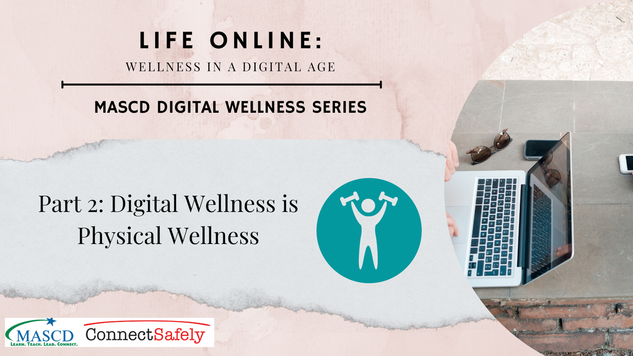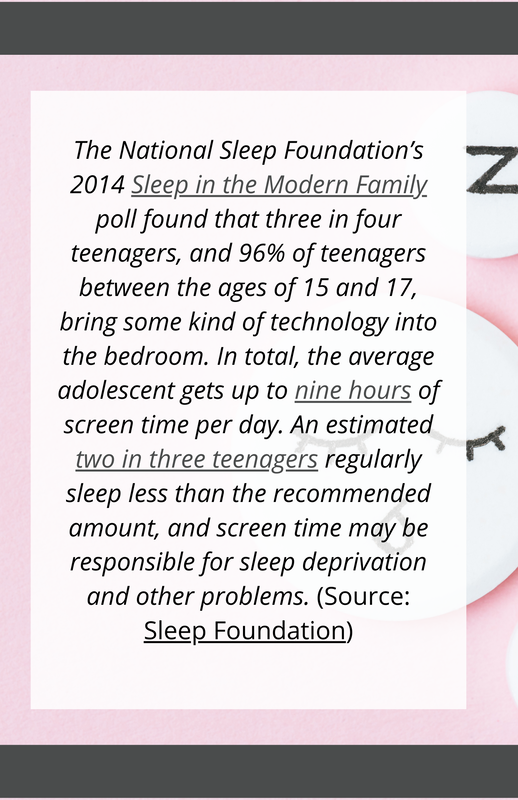One factor is blue light. It is available to us through sunlight and also through the screens we use throughout the day: smartphones, tablets, flatscreen TVs, and laptops. Blue light sends a signal to our brains that it is daytime and we should be active. Eliminating blue light can help signal to our brains to get ready for sleep. There are a few strategies to help with blue light exposure: using blue light blocking glasses or adjusting blue light settings on the devices used close to bedtime. So it is possible to use technology and get great sleep. We just need to be strategic about it. Exercise Just like sleep and screens, a common misconception is that technology and exercise are mutually exclusive. The stereotypical adolescent on a screen is in a dark room with eyes wide staring at the beam of light washing over his face, and planted next to him is a pile of junk food. Surely you can picture it in your mind. In reality, this is not how most families are allowing their children to engage with screens. In fact, there are ways to encourage children to use technology to promote physical activity. Here are some examples: Recently, my middle school-aged daughter tried out for and made a competitive sports team. This new team comes with expectations that athletes will practice at home, not just at designated team practice times. The coach sent home video demonstrations of drills that she wants athletes to do. My daughter spends many afternoons (or evenings after dark with the floodlights on) in the yard watching the videos and practicing the drills because she knows her coach will hold her accountable for improving her skills. During the pandemic, my elementary school-aged daughter engaged in physical education workouts via video clips shared by her teacher. She cleared out the living room and learned how to plank! Since then, on days when she doesn’t have an after school activity, I sometimes find her looking up workouts or dances on YouTube. She is motivated to learn how to move to her favorite songs and enjoys it because she knows that moving her body makes her feel good after a long school day. When she makes this choice, we celebrate it to encourage her. Here are even more ideas to promote physical activity that are combined with screen use with children even younger than elementary age. Eye Health The medical terminology for some of the symptoms we often associate with screen use – redness, itching, dryness, headache, halos, and double vision – is computer eye syndrome. Around half of parents of middle and high school aged students reported these symptoms during 2020 while our K through 12 learners were on screens for academic purposes more than ever before. Of course, it is important to remember that screens were not just being used for school. Our children used screens during this time to stay connected to family and friends, to pass the time with games and social media, and for entertainment with streaming content. Let’s be honest: they still use screens for all of these purposes.There are strategies to help mitigate these symptoms while allowing our learners to benefit from the resources, creation tools, and collaboration possibilities available through their screens. For instance, remind the children you serve to reduce the brightness a bit to only what is needed. The positioning of the screen should be even with eyes or a bit lower than eye level so lids can cover and moisten the eyes during screen use. Finally, children who are enjoying a movie or game are less likely to take breaks. Before they start those activities, make a plan for them to take eye breaks by working with them to set timers or schedule a meal or screen-free activity that will happen after 30-45 minutes. In the classroom Teachers and school leaders can proactively create classroom routines and talk about strategies like these with students and parents. Just as we plan for students to practice their mathematics skills, reading skills, and collaboration skills, we should plan intentionally for students to practice being physically healthy while benefiting from the features and programs provided by technology. I’m looking forward to seeing you back here soon. Our next Digital Wellness post will tackle the risks, benefits and strategies associated with Cognitive Health while using technology. Check out other articles in this series: What is Digital Wellness, Cognitive Wellness
and Emotional Wellnesswww.mascd.org/blog/digital-wellness-is-emotional-wellness.
0 Comments
|
Guest AuthorContact us at [email protected] to write for our organization! Categories |
Photo from Mike Kniec




 RSS Feed
RSS Feed